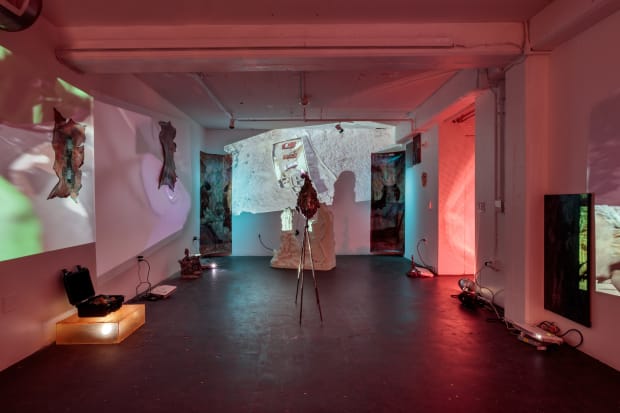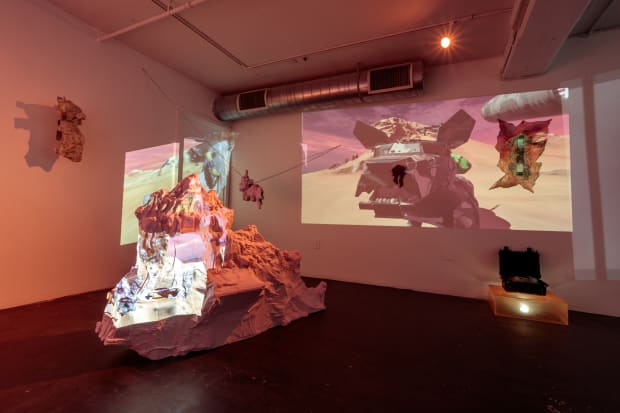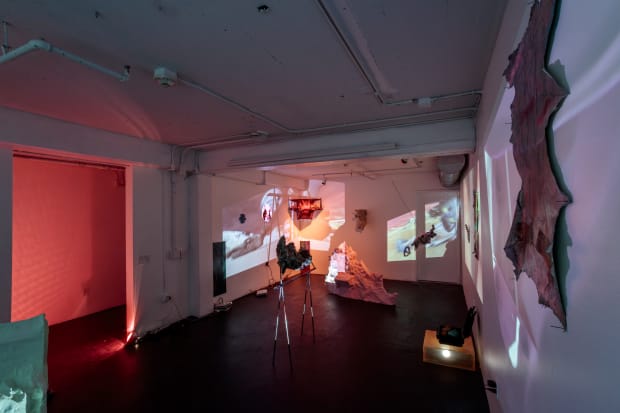
Hailing from the Emirates while simultaneously straddling the art scenes of Los Angeles and Dubai, Talal Al Najjar makes a return to the UAE with Postmordial Soup, a group exhibition featuring fellow artists Ziad Al Najjar and Miramar Al Nayyar. With a practice that transcends conventional boundaries, Talal navigates a diverse spectrum of artistic mediums, including sculpture, video, sound, CGI animation, painting, and immersive installations, among other forms. Through the lens of absurdism, he recontextualizes transhistorical material culture and imagery, offering viewers a glimpse into a world where the familiar and the uncanny converge.
Now, we sit down with the artist to delve deeper into his disruptive approach to exhibition viewing, his excavations of the past, and the uncanny and the alien which he observes in the everyday.

Talal: I’m an artist from Dubai, based between Los Angeles and Dubai. Driven by collecting, archiving, and distorting, my interdisciplinary practice recontextualizes transhistorical material culture and imagery with an absurdist lens. Defamiliarization and the uncanny teeter and prompt new anthropological and material questions in my work.
Talal: My primary concerns include ideas around simulation, poor images, artefacts, counter-futurisms, and the contention of postmodern conditions.
Talal: For the Postmordial Soup group exhibition, I’ve contributed paintings, sculptures, videos, sound, CGI animation, holograms, and other on-site interventions that engage with ideas relating to ancient history, our absurd/overwhelming/overstimulating/uncanny present, and potential futures. I’m engaging with organic and artificial forms and materials, technology, the human and non-human body, and the psychological effects of our uncanny contemporary reality/existence.

Talal: Ziad, Miramar, and I share interests and engage in overlapping themes, ideas, and formal and technical choices that resonate with each other. However, each of us has our individual practices and works that are distinct. We explore themes related to the body, our time, histories, alternative perspectives, and cultural heritage, among others.
Talal: We're collaborating in a non-salon-style manner, intervening in and around each other's work. The way we approach the show turns our works into more than just singular pieces placed in the same space; it becomes an orchestrated system that populates the world we're creating.
Talal: We aimed to create an experiential journey for viewers, immersing them in our world, where the uncanny takes centre stage. It's productive and generative to challenge people's preconceived notions of how to experience an art exhibition, disrupting their automated approach to navigating and engaging with artwork.

Talal: The imagery in my work spans transhistorical and material culture, from ancient artefacts of the Gulf to internet "shitpost" (meme-like) images circulating in global cyber-culture, particularly among 21st-century youth.
Talal: I believe my work presents a somewhat alien perspective, offering a defamiliarized and alien view of things familiar to humans, with an absurdist and ironic flare. This sense of alienation is a common thread connecting our works. All of us create works that almost become alien creatures in themselves, such as Miramar's "alien foetus" paintings, Ziad's abstracted alien-like forms, and my creaturesque subjects and objects. This alienation is not just about literal extraterrestrial beings but also relates to the increasingly alienating hyperreality we live in today, and concepts like feeling alien within one's own context, time, or home.
Talal: It's crucial for art and artists to maintain a continuous dialogue and conversation. Ziad, Miramar, and I belong to a specific generation with unique ideas, perspectives, and opinions that resonate with one another and should be shared. In our contemporary world marked by hyper-drive pace, alienation, dissociation, and augmentation, artists like us respond and react in our expressive ways.

This website uses cookies
This site uses cookies to help make it more useful to you. Please contact us to find out more about our Cookie Policy.